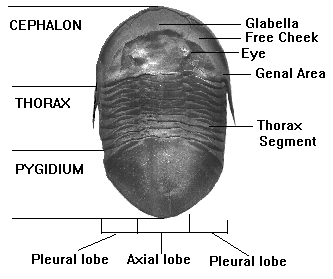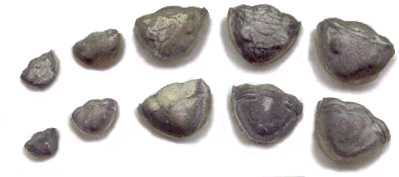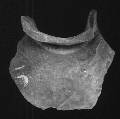Trilobite Isotelus maximus

The Anatomy of Isotelus
Isotelus maximus range in size from less than a millimeter to as long as
24 inches. The exoskeleton of this giant of trilobite is usually found in
fragments. For this reason, most people only find parts of Isotelus trilobite.
Isotelus maximus has been found whole, but this is quite unusual and a
great treasure. Usually, complete specimens of Isotelus are found in
hundreds of pieces that must be meticulously reassembled. You will probably be
satisfied finding parts of Isotelus often several inches long. You may get lucky
and find a complete specimen of enrolled Isotelus as small as a pebble. The
pictures below will help you find and identify evidence to what this fascinating
giant trilobite looked like.

Enrolled Isotelus maximus
courtesy of Ron Fine.
Pictures and Descriptions
(Click on a picture to see a close-up.)
 |
This is an Isotelus eye. The eye appears as a smooth bump on a
cephalon fragment. |
 |
This fragment of the genal area shows part of the genal spine and a
distinct hole that characterizes the genal area. |
 |
This is a genal spine. It is one of the most common fragments of the Isotelus
found. |
 |
Here, the entire "free cheek" was found encased in crinoid
stems and matrix. Note the apparently large eye. |
 |
The hypostoma, or "mouth plate" of the Isotelus is a
very recognizable body part that is commonly found as the result of
molting. Found on the underside of the trilobite, the hypostoma looks like
a pair of fang-like lobes with distinctive curvy lines and a pair of
"dimples" above the lobes. Oddly enough, one lobe is typically
bigger than the other. Click the picture to see these markings. The side
shown in this picture faces outward on the underside of the trilobite. |
 |
The other side of the Isotelus hypostoma also has distinct
markings. Fine ridges like corduroy run diagonally across each lobe. The
interior of the hypostoma is hollow. |
 |
The center of the Isotelus hypostoma is often found separated from the
two lobes. The result is a shell fragment with what appears to be a lip.
This is a loosely applied description because if trilobites had lips, they
would certainly be soft body parts. |
 |
The pygidium, or "tail section" of the Isotelus is one
contiguous plate. Consequentially, it is often found complete in the
fossil record. However, small fractures are usually visible due to the
exoskeleton's fragile nature. |
 |
The ends of thoracic segments are often found cemented together in
groups preserving the distinctive shape of the pleural lobe. |
 |
Individually, the ends of each thoracic segment resemble the paddle on
an oar of a boat. This commonly found fragment is often mistaken for a
hypostoma (mouth plate), but is missing the fine lines on its surface. |
 |
Occasionally, you will find part of a pygidium of Isotelus with
one or more thoracic segments still attached. This is a rare treasure. |
 |
Single thoracic segments are often found on the surface of a rock. It
appears as a unique brown stripe. |
Here's more information!
Fragments of other Cincinnati Trilobites
Flexicalymene
Cryptolithus 
Ceraurus milleranus, Ceraurinus icarus and
Allolichas shideleri 
Back to Trilobite Fragments Identifier Introduction
Some Other Cincinnati Trilobites
Dry Dredgers Home Page
www.isotelus.com (Dan Cooper's Cincinnati Trilobites
Page)
The trilobite anatomy chart was done with an Isotelus
replica from a specimen found by Dan Cooper, Dry Dredger member. The Isotelus
fragments shown are from the collections of the Dry Dredgers, an association
of amateur geologists and fossil follectors. The Cincinnati Trilobite Fragment Identifier was
written and produced by Bill Heimbrock, Dry Dredger member.
The Dry Dredgers and individual contributors reserve the
rights to all information, images, and content presented here. Permission to
reproduce in any fashion, must be requested in writing to admin@drydredgers.org.
www.drydredgers.org is designed and
maintained by Bill Heimbrock.


![]()
![]()